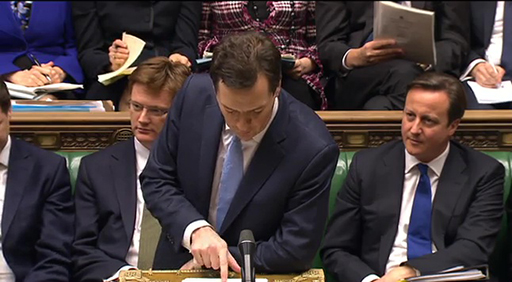2.2 Taxation and benefits
Take a look at deductions that are made to income in the UK in the form of Income Tax and National Insurance. Consider the income that comes in the form of state benefits and review the current overhaul of the UK benefits system.
In the video George Osborne, UK Chancellor of the Exchequer, announces his proposals for tax changes to a packed House of Commons.

Transcript
Here we start to look in more detail at the deductions (for Income Tax and National Insurance in the UK) and additions (through benefit payments) that take us from gross to net income. (Note that for some people another possible deduction from gross income is contributions to their pension scheme: these schemes are discussed later in the course.)
Income Tax is levied on almost all types of income, including paid employment. When it is collected via an employer it is often referred to as a ‘pay as you earn’ (PAYE) tax. Income Tax is paid on income received within a given tax year, from 6 April of one year to 5 April of the following year. Income Tax is the single largest source of government revenue. In 2016/17, Her Majesty’s Revenue & Customs (HMRC), the government department responsible for collecting taxes, collected £176 billion in Income Tax – close to a third of all government receipts (ONS, 2017).
In the UK Income Tax system most people receive an ‘allowance’ of income that can be earned before Income Tax has to be paid. This ‘personal allowance’ is £11,850 in 2018/19. The allowance is higher for certain groups of people, such as those who are registered blind. The personal allowance has an income limit of £100,000. Above this limit the allowance tapers away.
Income above the personal allowance is then subject to tax at three different standard rates in English, Wales and Northern Ireland (Gov.UK, 2018):
- in 2018/19 the first £34,500 (after the basic allowance has been taken into account) is taxed at 20%
- above this figure and up to £150,000 of taxable income, the rate is 40%
- there is an additional rate of 45% on taxable incomes over £150,000.
Since 1999 Scotland has had some discretion over its income tax rates. These powers were extended in 2016 and 2017 giving the Scottish Parliament full discretion over the income tax rates and bands applied to non-savings income. Discretion over income tax is also planned to be extended to Wales and Northern Ireland.
Using its discretion the Scottish Parliament approved the following income tax rates and bands for 2018/19 (BBC, 2017).
| Income Band | Name of Band | Tax Rate |
|---|---|---|
| £0 - £11,850 (personal allowance) | Personal Allowance | 0% |
| £11,851 - £13,850 | Starter Rate | 19% |
| £13,851 - £24,000 | Basic Rate | 20% |
| £24,001 - £44,273 | Intermediate Rate | 21% |
| £44,274 - £150,000 | Higher Rate | 41% |
| £150,001 and above | Additional Rate | 46% |
By taxing additional income slices at higher rates, the proportion of tax increases with income. UK Income Tax is an example of progressive taxation, meaning that the proportion of a person’s income paid as tax increases as their income increases. This tax structure therefore helps to reduce income inequalities in the UK.
Next, have a go at using what you’ve learned here to try some calculations for yourself.
